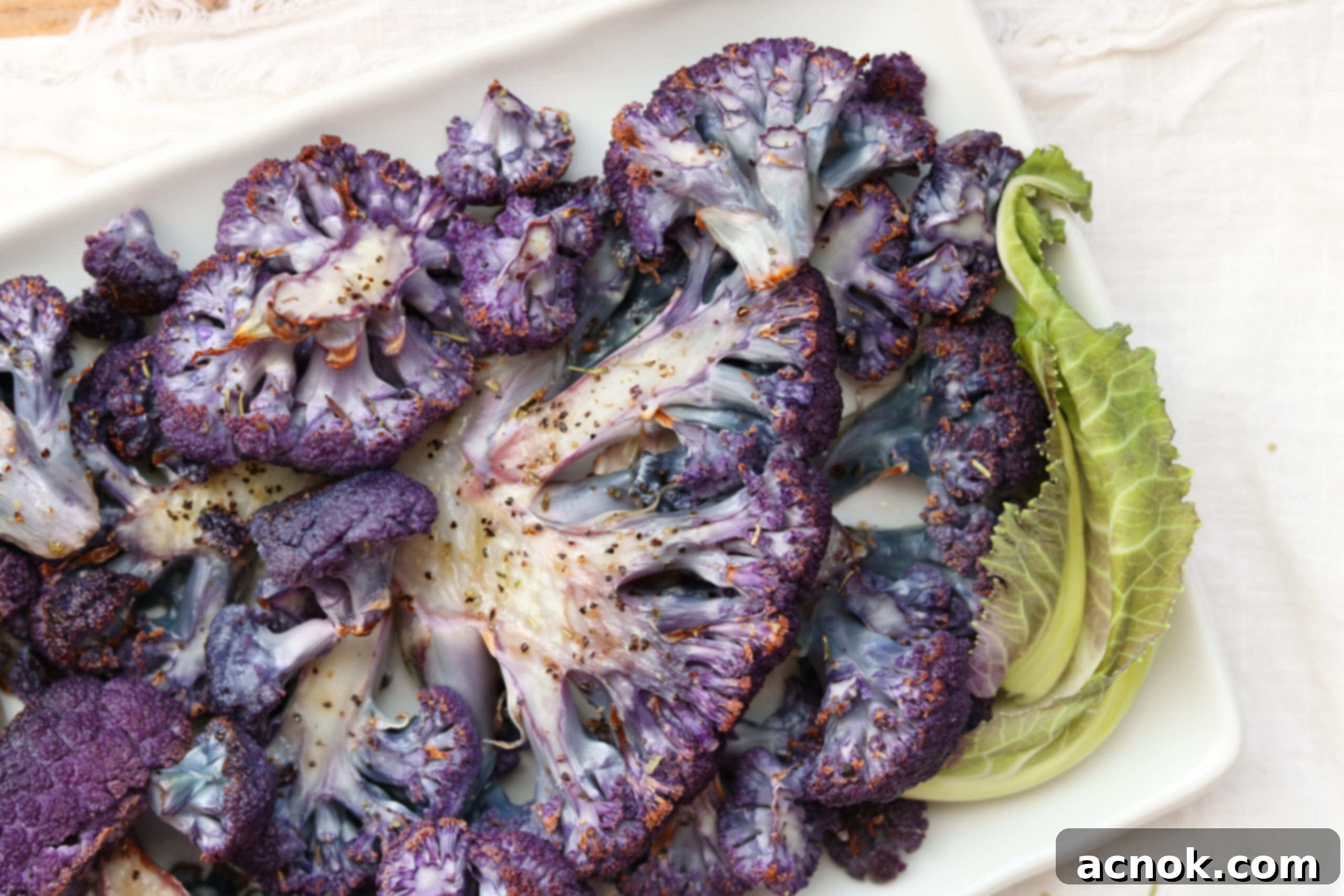Perfectly Roasted Purple Purple Cauliflower: An Easy & Vibrant Side Dish Recipe
Nothing heralds the arrival of Spring quite like the brilliant hues of fresh vegetables, and roasted purple cauliflower, along with its colorful cousins, truly shines. This striking vegetable is a personal favorite for Spring holidays like Easter, adding an unforgettable pop of color to any table. But beyond its stunning appearance, purple cauliflower is a natural wonder. Its distinctive purple color comes from anthocyanin, a powerful antioxidant also found in purple cabbage and red wine. As highlighted by The Kitchn, this vibrant variant boasts 25% more Vitamin A than its white counterpart. Isn’t that a delightful bonus?
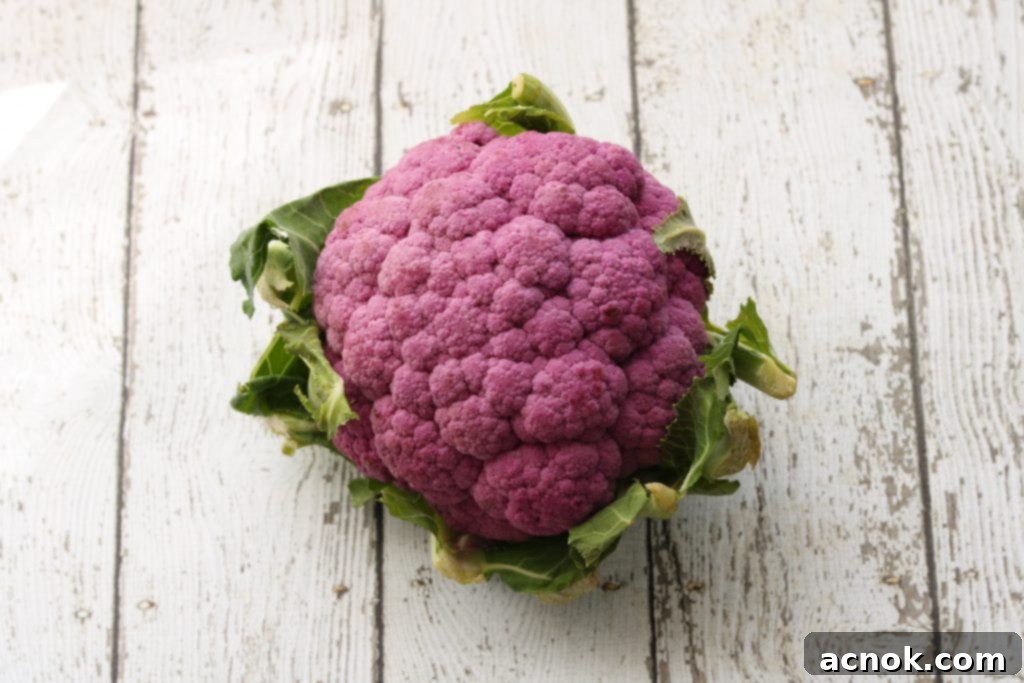
This recipe is so straightforward, you might hesitate to even call it a “recipe.” Its true brilliance lies in the glorious transformation of color and texture, from raw to perfectly roasted. The result is a feast for both the eyes and the palate! Don’t have purple cauliflower on hand? No worries! White cauliflower roasts just as beautifully and makes an equally delicious side. For me, roasted vegetables are a culinary cornerstone – simple, wholesome, and incredibly satisfying.
The Magic Behind Purple Cauliflower
While often seen as a trendy, exotic vegetable, purple cauliflower is actually a naturally occurring variant, not genetically modified. Its stunning color comes from anthocyanins, the same antioxidants responsible for the deep reds, blues, and purples in fruits and vegetables like blueberries, red grapes, and even purple cabbage. These compounds are not just pigments; they are potent antioxidants known for their potential health benefits, including anti-inflammatory properties and support for cardiovascular health.
Nutritional Powerhouse
Beyond the aesthetic appeal and anthocyanins, purple cauliflower offers a robust nutritional profile. As mentioned, it contains significantly more Vitamin A than white cauliflower, contributing to healthy vision, immune function, and skin health. Like all cauliflower, it’s also an excellent source of Vitamin C, a crucial antioxidant for immunity, and Vitamin K, vital for blood clotting and bone health. Furthermore, it provides a good amount of dietary fiber, promoting digestive health and satiety, along with various B vitamins and essential minerals.
Does it Taste Different?
Many people wonder if purple cauliflower tastes different from white cauliflower. Generally, the flavor is quite similar, perhaps even slightly milder or sweeter, with a subtle nutty undertone that becomes more pronounced upon roasting. Its texture is firm yet tender, holding up wonderfully to high heat. So, if you’re a fan of traditional roasted cauliflower, you’ll absolutely adore this colorful version, perhaps even more!
Mastering the Art of Roasted Purple Cauliflower
Roasting is arguably the best way to prepare cauliflower. The high heat of the oven caramelizes the natural sugars in the florets, creating a slightly sweet, deeply flavorful, and tender-crisp vegetable with deliciously charred edges. This simple cooking method brings out the best in cauliflower, transforming it from a humble cruciferous vegetable into a truly craveable dish. The process is incredibly forgiving, making it perfect for novice cooks and seasoned chefs alike.
Choosing and Preparing Your Cauliflower
When selecting a head of purple cauliflower, look for one that is firm, dense, and vibrant in color. Avoid any with soft spots, discoloration, or a strong odor. To prepare, you can cut it up any way you want, but for roasting, I start by slicing it into “steaks” or florets. Slicing can provide a unique presentation, offering larger surface areas for caramelization.
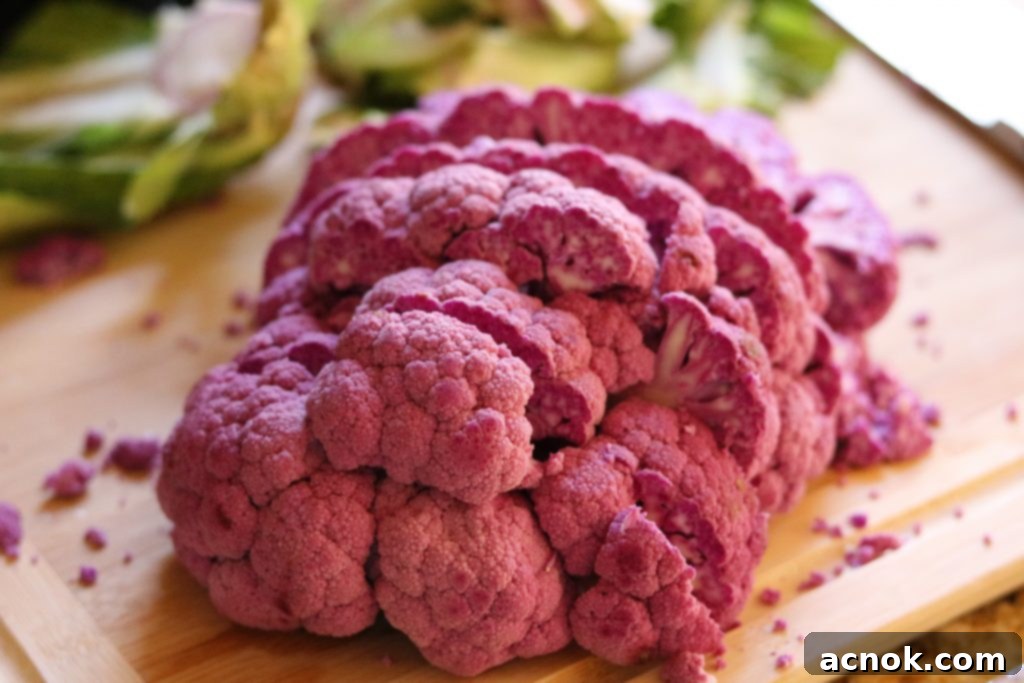
Once sliced or broken into florets, ensure the cauliflower is thoroughly washed and, most importantly, completely dry. Excess moisture can lead to steaming rather than roasting, preventing those coveted crispy edges. A salad spinner or a few gentle pats with a clean kitchen towel can do the trick.
The Simple Seasoning Process
The beauty of roasted cauliflower lies in its simplicity. Place your beautiful cauliflower pieces on a rimmed baking sheet. I always line my baking sheet with parchment paper for easy cleanup and to prevent sticking. Then, it’s time for the essentials:
- Olive Oil: Drizzle with a generous amount of good quality extra virgin olive oil. This is crucial not just for flavor but also for achieving that lovely crisp texture and promoting even browning.
- Salt & Pepper: Season generously with salt and freshly ground black pepper. These basic seasonings enhance the natural sweetness of the cauliflower.
- Herbes de Provence: This aromatic French herb blend is my secret weapon for elevating this dish. It typically includes savory, marjoram, rosemary, thyme, and oregano, sometimes with lavender. Its fragrant profile perfectly complements the earthy notes of cauliflower. If you don’t have Herbes de Provence, a mix of dried Italian herbs, rosemary, and thyme would be a great substitute.
Toss everything together directly on the baking sheet to ensure every piece is evenly coated. This ensures maximum flavor and optimal caramelization.
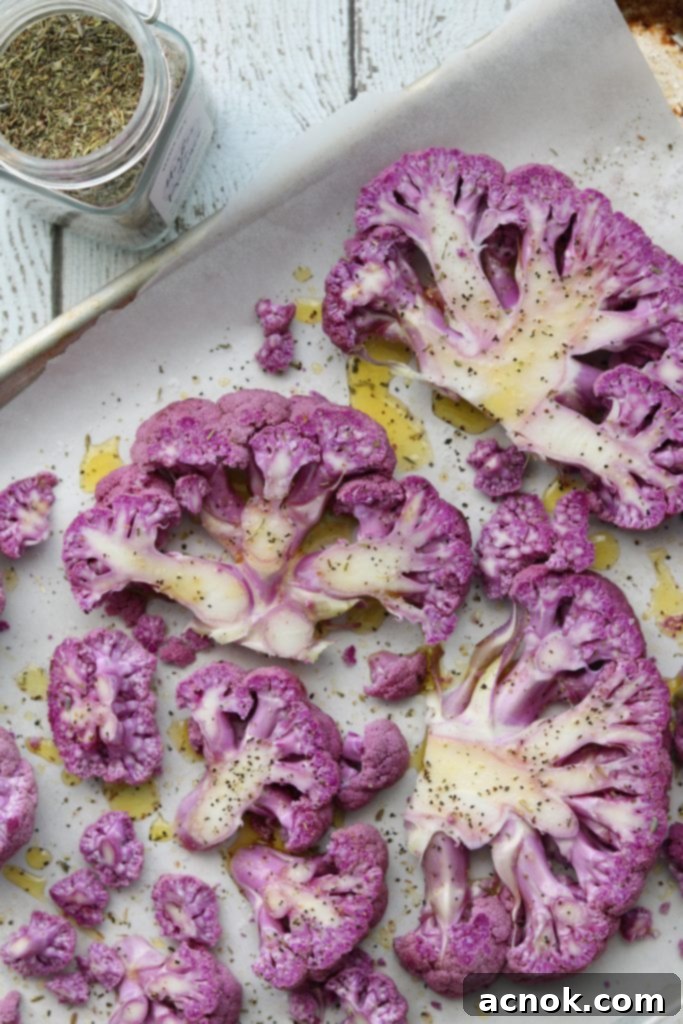
Roasting to Perfection
Preheat your oven to 400 degrees Fahrenheit (200 degrees Celsius). This high temperature is ideal for roasting vegetables, ensuring they cook quickly while developing a beautiful crust. Make sure your cauliflower is spread out in a single layer on the baking sheet. Overcrowding the pan will cause the cauliflower to steam instead of roast, leading to a soggy result. If necessary, use two baking sheets.
Roast for about 20-25 minutes, or until the cauliflower is tender when pierced with a fork and beautifully caramelized with slightly browned or crispy edges. The vibrant purple hue will intensify and become even more captivating. Keep an eye on it, as oven temperatures can vary. And then, the waiting pays off…
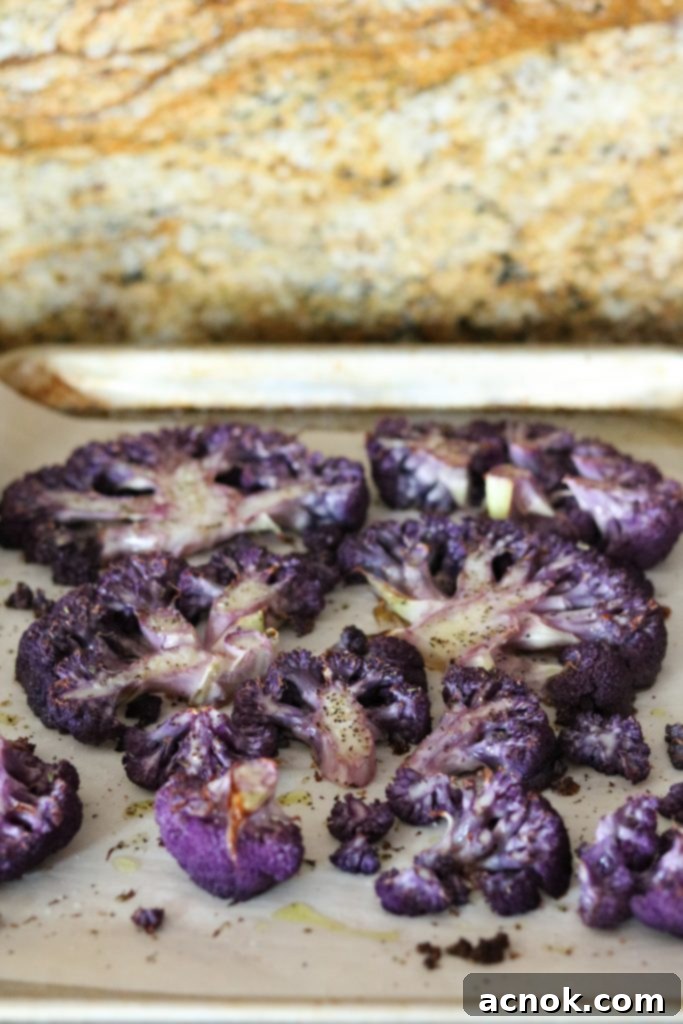
Behold, roasted purple cauliflower—your new culinary obsession! Just look at that stunning hue, folks! It’s so gorgeous, making it not just a meal component but a centerpiece.
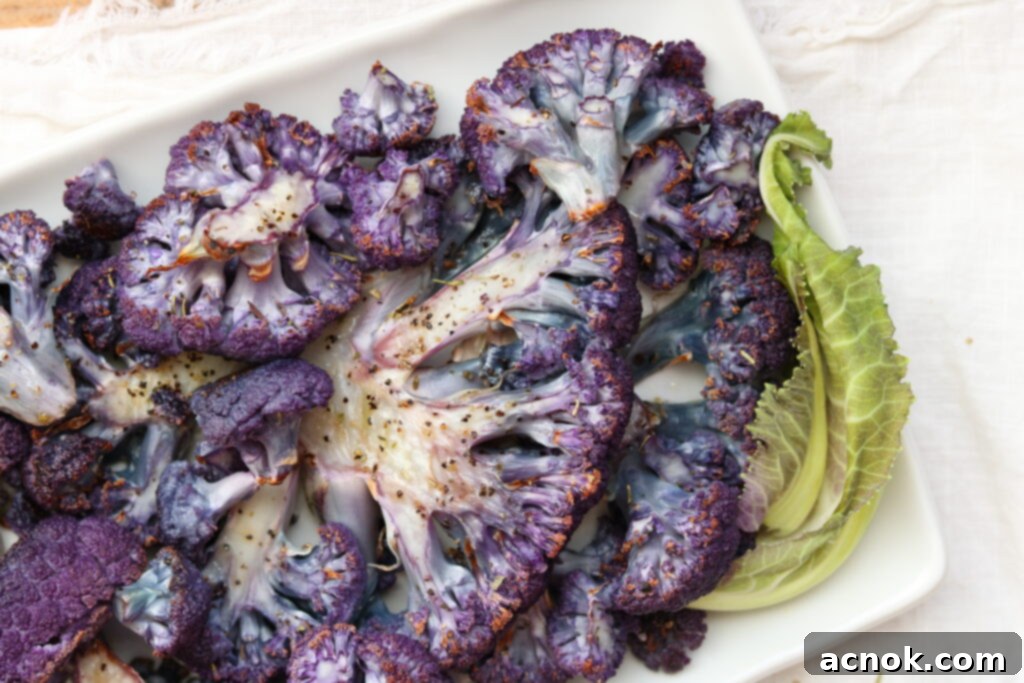
Serving Suggestions & Flavor Pairings
The versatility of roasted purple cauliflower is truly endless. It makes an excellent side dish for almost any meal. I often serve my roasted cauliflower alongside a succulent Pork Loin with Rosemary Lemon Pan Sauce, creating a harmonious and flavorful plate. But its utility extends far beyond traditional pairings:
- Power Bowls: It’s an excellent addition to a hearty power bowl, providing texture, flavor, and a nutritional boost.
- Appetizer: Arrange it on a cheese board or charcuterie platter for a unique and colorful appetizer.
- Salads: Toss cooled roasted florets into your favorite green salad or grain salad for added depth.
- Tacos & Wraps: Use it as a vegetarian filling for tacos, wraps, or pita pockets.
- Purees & Dips: Blend it into a creamy soup or a vibrant dip with a hint of garlic and tahini.
- Standalone Snack: It’s so delicious on its own, you might just find yourself snacking on it straight from the pan!
To further enhance its flavor, consider a finishing touch: a squeeze of fresh lemon juice, a sprinkle of toasted sesame seeds, a drizzle of balsamic glaze, or a scatter of fresh parsley or cilantro. The options are truly as endless as your culinary creativity. Did we talk about the beautiful color yet? Oh, right, we did… several times! Because it’s truly captivating!
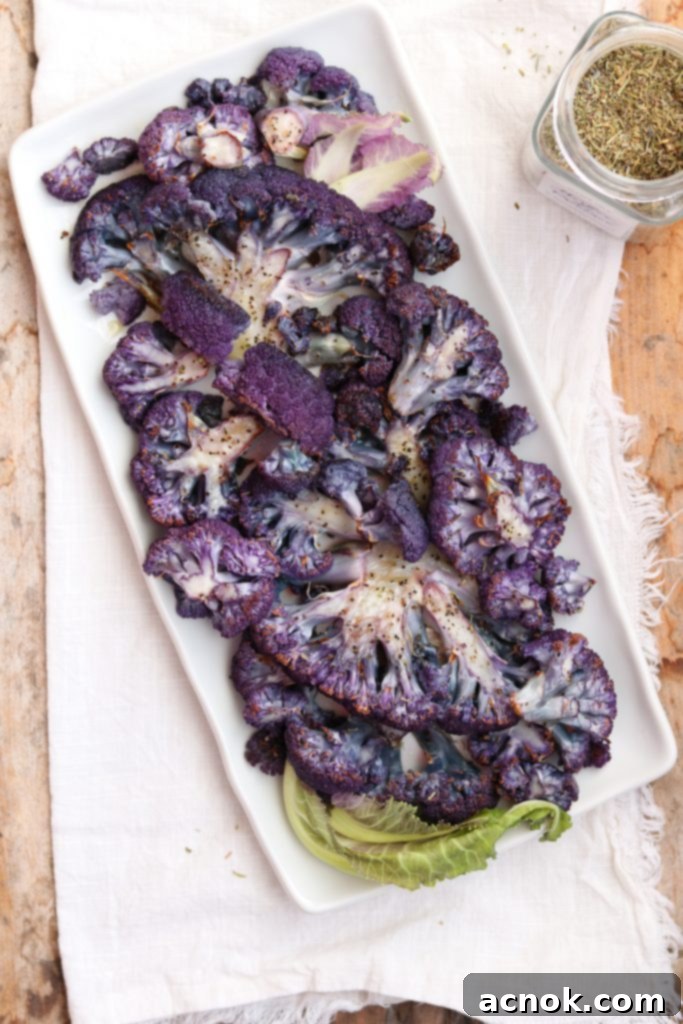
Looking for more ways to use Herbes de Provence? This versatile blend can elevate many dishes. Click here to explore more recipes, including Roast Herb Chicken and Kitchen Sink Bean Salad.
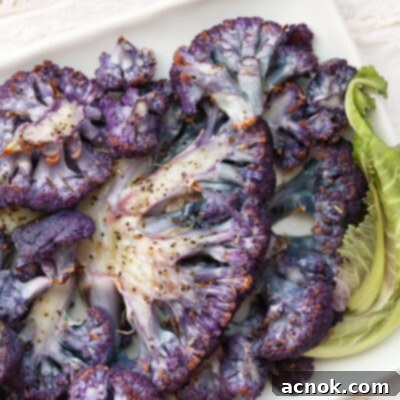
Roasted Purple Cauliflower
Ana | Claudia’s Table
February 27, 2020
Pin Recipe
Equipment
-
rimmed baking sheet
-
parchment paper
Ingredients
- 1 head Purple Cauliflower sliced
- 2 tbsp olive oil extra virgin
- 2 tsp Herbes de Provence dried
- salt
- pepper
Instructions
-
Preheat oven to 400 degrees Fahrenheit (200 degrees Celsius).
-
Wash and thoroughly dry the head of purple cauliflower. Slice it into “steaks” or break it into bite-sized florets, ensuring uniform size for even cooking.
-
Place these beautiful bits on a baking sheet lined with parchment paper. Arrange them in a single layer to prevent steaming.
-
Drizzle generously with extra virgin olive oil, add salt and pepper to taste, and a nice sprinkling of Herbes de Provence. Toss well to ensure all cauliflower pieces are coated.
-
Roast for about 20-25 minutes, or until the cauliflower is tender when pierced with a fork and has achieved lovely caramelization with slightly browned tips.
Notes
For an extra boost of flavor, squeeze fresh lemon juice over the roasted cauliflower before serving, or sprinkle with a handful of fresh parsley. You can also experiment with other herb blends like Italian seasoning or a pinch of red pepper flakes for a subtle kick. Ensure your cauliflower is completely dry before adding oil and roasting to achieve the best crispy texture.
Nutrition
Nutritional information is calculated online and should be used as a guide.
All content and photographs ©Claudia’s Table and claudiastable.com
Troubleshooting Common Roasting Issues
Even with a simple recipe like this, a few common issues can arise. Here’s how to avoid them and ensure perfect results every time:
- Soggy Cauliflower: The most common culprit is overcrowding the baking sheet. When florets are too close together, they release moisture and steam instead of roast. Always ensure a single layer with a little space between each piece. Also, make sure the cauliflower is completely dry before adding oil and roasting.
- Burnt but Not Tender: If your cauliflower is scorching on the outside but still hard in the middle, your oven might be too hot, or your florets might be too large. Try cutting the florets into smaller, more uniform pieces and/or slightly reducing the oven temperature.
- Lack of Flavor: Don’t be shy with the seasoning! Cauliflower can absorb a lot of flavor. Ensure you’re using a good amount of olive oil, and don’t skimp on the salt, pepper, or Herbes de Provence. A final squeeze of lemon juice after roasting can also brighten the flavors considerably.
Conclusion: A Staple for Your Kitchen
Roasted purple cauliflower is more than just a visually appealing dish; it’s a testament to how simple ingredients can create extraordinary flavor and nutrition. Its ease of preparation, combined with its striking color and health benefits, makes it a perfect addition to any meal plan. Whether you’re looking for a vibrant side dish for a special occasion, a healthy component for your weeknight dinner, or just a delicious way to enjoy more vegetables, this recipe is sure to become a beloved staple in your kitchen. Embrace the beautiful purple hue and delight in the tender, flavorful results!
